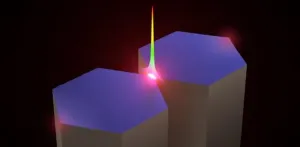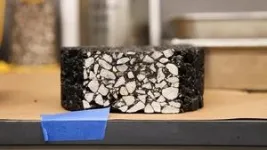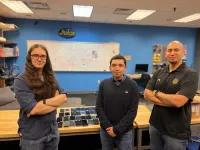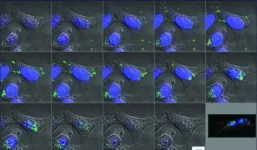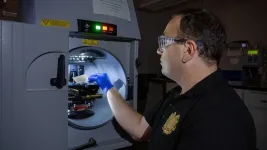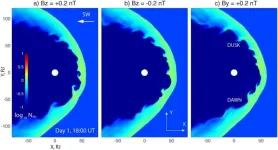(Press-News.org) Imagine shrinking light down to the size of a tiny water molecule, unlocking a world of quantum possibilities. This has been a long-held dream in the realms of light science and technology. Recent advancements have brought us closer to achieving this incredible feat, as researchers from Zhejiang University have made groundbreaking progress in confining light to subnanometer scales.
Traditionally, there have been two approaches to localize light beyond its typical diffraction limit: dielectric confinement and plasmonic confinement. However, challenges such as precision fabrication and optical loss have hindered the confinement of optical fields to sub-10 nanometer (nm) or even 1-nm levels. But now, a new waveguiding scheme reported in Advanced Photonics promises to unlock the potential of subnanometer optical fields.
Picture this: light travels from a regular optical fiber, embarking on a transformative journey through a fiber taper, and finding its destination in a coupled-nanowire-pair (CNP). Within the CNP, the light morphs into a remarkable nano-slit mode, generating a confined optical field that can be as tiny as a mere fraction of a nanometer (approximately 0.3 nm). With an astonishing efficiency of up to 95 percent and a high peak-to-background ratio, this novel approach offers a whole new world of possibilities.
The new waveguiding scheme extends its reach into the mid-infrared spectral range, pushing the boundaries of the nano-universe even further. Optical confinement can now reach an astonishing scale of approximately 0.2 nm (λ/20000), offering even more opportunities for exploration and discovery.
Professor Limin Tong of the Zhejiang University Nanophotonics Group notes, “Unlike previous methods, the waveguiding scheme presents itself as a linear optical system, bringing a host of advantages. It enables broadband and ultrafast pulsed operation and allows for the combination of multiple sub-nanometer optical fields. The ability to engineer spatial, spectral, and temporal sequences within a single output opens up endless possibilities.”
The potential applications of such breakthroughs are awe-inspiring. An optical field so localized that it can interact with individual molecules or atoms holds promise for advancements in light–matter interactions, super-resolution nanoscopy, atom/molecule manipulation, and ultrasensitive detection. We stand at the precipice of a new era of discovery, where the tiniest realms of existence are within our grasp.
Check out this video summary with an animated demonstration from the authors:
https://players.brightcove.net/689254975001/SyeYVVul4l_default/index.html?videoId=6331129848112
Read the Gold Open Access article by L. Yang, Z. Zhou, et al., “Generating a sub-nanometer-confined optical field in a nanoslit waveguiding mode,” Adv. Photon. 5(4), 046003 (2023), doi 10.1117/1.AP.5.4.046003.
END
Shrinking light: Nanoscale optical breakthrough
Waveguiding scheme enables highly confined subnanometer optical fields
2023-07-17
ELSE PRESS RELEASES FROM THIS DATE:
UMD researchers uncover privacy risks in cellphones purchased at police auctions
2023-07-17
Law enforcement agencies nationwide regularly sell items that are seized in criminal investigations or are unclaimed from lost-and-found inventories. Many of these items—vehicles, jewelry, watches and electronic devices like cellphones—end up at online auction houses.
People looking for a bargain can bid on cellphones in bulk, snatching up dozens at rock bottom prices for parts or other uses. This ultimately provides revenue for the police agencies, making for a good deal for everyone involved. Or is it?
A recent study by University of Maryland security experts found that many of the phones sold ...
Bacterial protein found in the urogenital tract may contribute to reduced fertility, birth defects
2023-07-17
A team of researchers from the University of Maryland School of Maryland’s (UMSOM) Institute of Human Virology (IHV), a Center of Excellence of the Global Virus Network (GVN), published new findings that emphasize the crucial role of the urinary and genital tract microbiota in adverse pregnancy outcomes and genomic instability that originate in the womb during fetal development.
The study, published on July 17 in the Proceedings of the National Academy of Sciences of the United States of America (PNAS), established a new link between genomic instability and a protein from Mycoplasma fermentans, a kind of bacterium that commonly ...
Picky green sea turtle has travelled to the same place to eat for generations
2023-07-17
For approximately 3,000 years, generations of green sea turtles have returned to the same seagrass meadows to eat. This was discovered by Willemien de Kock, a historical ecologist at the University of Groningen, by combining modern data with archaeological findings. Sea turtles migrate between specific breeding places and eating places throughout their lives–this much was known. But the fact that this stretches over many generations highlights the importance of protecting seagrass meadows along the coasts of North Africa. The results were published in PNAS on July 17.
When young green ...
How skin cancer virus outcompetes host cell replication
2023-07-17
University of Pittsburgh researchers have shown for the first time how Merkel cell polyomavirus (MCV), which causes an aggressive skin cancer called Merkel cell carcinoma, initiates DNA replication in host cells.
Published today in the journal PNAS, the study sheds light on the fundamental question of how viruses override their host cells’ carefully regulated DNA replicating system to make hundreds of new copies of themselves.
“Understanding how MCV replicates gives us really important clues about ...
All about the Benjamins: Researchers decipher the secrets of Benjamin Franklin’s paper money
2023-07-17
Benjamin Franklin may be best known as the creator of bifocals and the lightning rod, but a group of University of Notre Dame researchers suggest he should also be known for his innovative ways of making (literal) money.
During his career, Franklin printed nearly 2,500,000 money notes for the American Colonies using what the researchers have identified as highly original techniques, as reported in a study published this week in the Proceedings of the National Academy of Sciences.
The research team, led by Khachatur ...
Redlining linked to higher heart failure risk among Black adults in US
2023-07-17
Research Highlights:
An analysis of more than two million adults in the U.S. found that present day heart failure risk was higher among Black adults who lived in zip codes historically impacted by redlining compared to Black adults living in non-redlined areas.
Redlining did not have the same impact on heart failure risk among white adults living in historically redlined zip codes.
Among Black adults living in historically redlined communities, approximately half of the excess risk of heart failure appeared to be explained by higher levels of socioeconomic distress.
Embargoed until 1 p.m. CT/2 p.m. ET Monday, July 17, ...
Racial disparities discovered in patients with cardiac devices
2023-07-17
Black patients with implantable cardioverter defibrillators (ICDs) have a significantly higher burden of disease than white patients with the same device, according to a new study from University of Rochester Medical Center (URMC) cardiology researchers. Analyzing data from clinical trials conducted over a 20-year period by the Clinical Cardiovascular Research Center (CCRC) at URMC, investigators concluded that not only did Black patients with ICDs tend to be significantly younger than white patients, but they also had a higher ...
SwRI team identifies giant swirling waves at the edge of Jupiter’s magnetosphere
2023-07-17
SAN ANTONIO — July 17, 2023 —A team led by Southwest Research Institute (SwRI) and The University of Texas at San Antonio (UTSA) has found that NASA’s Juno spacecraft orbiting Jupiter frequently encounters giant swirling waves at the boundary between the solar wind and Jupiter’s magnetosphere. The waves are an important process for transferring energy and mass from the solar wind, a stream of charged particles emitted by the Sun, to planetary space environments.
Jake Montgomery, a doctoral student in the joint space physics program ...
Immune cells in single file
2023-07-17
The cells of the immune system circulate mainly in the blood and migrate into the body's tissues after an inflammation. Some types of immune cells, however, are permanently located in the tissues, where they come together to form three-dimensional networks.
How do these networks form and how are they maintained? For the long-lived macrophages (phagocytes), the answer is already known: They settle in so-called niches. These are environments of connective tissue cells that supply the macrophages with nutrients and keep them ...
New research shows babies’ immunological weak spot and strength
2023-07-17
NEW YORK, NY--A pair of new studies led by researchers at Columbia University explains why babies get so many common respiratory infections and identifies a specialized cluster of immune cells found only in babies that help them better cope with new pathogens.
“We know little about how the immune system develops throughout life, and most of what we know about immune system development in children comes from animal studies,” says Donna Farber, PhD, an expert in immune system development at Columbia University ...
LAST 30 PRESS RELEASES:
Tracing the quick synthesis of an industrially important catalyst
New software sheds light on cancer’s hidden genetic networks
UT Health San Antonio awarded $3 million in CPRIT grants to bolster cancer research and prevention efforts in South Texas
Third symposium spotlights global challenge of new contaminants in China’s fight against pollution
From straw to soil harmony: International team reveals how biochar supercharges carbon-smart farming
Myeloma: How AI is redrawing the map of cancer care
Manhattan E. Charurat, Ph.D., MHS invested as the Homer and Martha Gudelsky Distinguished Professor in Medicine at the University of Maryland School of Medicine
Insilico Medicine’s Pharma.AI Q4 Winter Launch Recap: Revolutionizing drug discovery with cutting-edge AI innovations, accelerating the path to pharmaceutical superintelligence
Nanoplastics have diet-dependent impacts on digestive system health
Brain neuron death occurs throughout life and increases with age, a natural human protein drug may halt neuron death in Alzheimer’s disease
SPIE and CLP announce the recipients of the 2025 Advanced Photonics Young Innovator Award
Lessons from the Caldor Fire’s Christmas Valley ‘Miracle’
Ant societies rose by trading individual protection for collective power
Research reveals how ancient viral DNA shapes early embryonic development
A molecular gatekeeper that controls protein synthesis
New ‘cloaking device’ concept to shield sensitive tech from magnetic fields
Researchers show impact of mountain building and climate change on alpine biodiversity
Study models the transition from Neanderthals to modern humans in Europe
University of Phoenix College of Doctoral Studies releases white paper on AI-driven skilling to reduce burnout and restore worker autonomy
AIs fail at the game of visual “telephone”
The levers for a sustainable food system
Potential changes in US homelessness by ending federal support for housing first programs
Vulnerability of large language models to prompt injection when providing medical advice
Researchers develop new system for high-energy-density, long-life, multi-electron transfer bromine-based flow batteries
Ending federal support for housing first programs could increase U.S. homelessness by 5% in one year, new JAMA study finds
New research uncovers molecular ‘safety switch’ shielding cancers from immune attack
Bacteria resisting viral infection can still sink carbon to ocean floor
Younger biological age may increase depression risk in older women during COVID-19
Bharat Innovates 2026 National Basecamp Showcases India’s Most Promising Deep-Tech Ventures
Here’s what determines whether your income level rises or falls
[Press-News.org] Shrinking light: Nanoscale optical breakthroughWaveguiding scheme enables highly confined subnanometer optical fields
